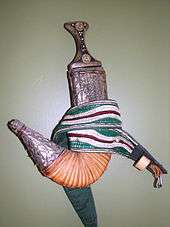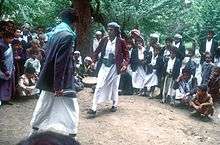Janbiya

Janbiya, also spelled janbia, jambiya, and jambia (Arabic: جنبية janbīyah), is the Arabic term for dagger, but it is generally used to describe a specific type of dagger with a short curved blade and a medial ridge. Though the term janbiya is used in various Arab countries and India, it is most closely associated with the people of Najran in Saudi Arabia, and Yemen. It is also prevalent among Muslim men in the Horn of Africa (primarily the Afars of Djibouti). Men typically above the age of 14 wear it as an accessory to their clothing.[1] In Oman the janbiya is commonly referred to as a khanjar.
Types

Janbiya were taken by travelers to other cultures including Persia, the Ottoman empire, and India,[2]were they adopted with slight differences to the blade, hilt and scabbard.
The hilt or handle
A significant part of a janbiya is its hilt (handle). The saifani hilt is made of rhinoceros horn, which can cost up to $1500 per kilogram, it is used on the daggers of wealthier citizens. Different versions of saifani hilts can be distinguished by their colour. Other janbiya hilts are made of different types of horn, wood, metal and ivory from Elephants and walrus. Apart from the material used for the hilt, the design and detail is a measure of its value and the status of its owner.[3]
Blade, sheath and belt

The double edged blade of the janbiya is constructed of steel which in some cases is damascus or wootz steel. The blade is stored in a sheath, usually made of wood covered with metal or cloth. The sheath can be decorated with various ornaments that signify status. These include silver work, semi-precious stones, and leather. The sheath can be fixed to a leather belt, which is normally 2–3 inches wide. The belt is usually worn around the lower abdomen. There are often other items attached to this belt, such as a silver purse for containing money and change.[3]
Use
Despite the significance of the janbiya, it is still a weapon. Although people have used it in times of dispute, there are societal and Islamic norms that must be followed in order to avoid defamation. The janbiya should only come out of its sheath in extreme cases of conflict. It is also commonly used in traditional events, such as dances.
Like with some other curved knives, as the blade bends towards the opponent, the user need not angle the wrist, which makes it more comfortable as a stabbing weapon than straight-bladed knives. Its heavy blade enables the user to inflict deep wounds and to cut through muscle and bone. It also makes it possible to cut and twist the blade upwards, slitting internal organs such as intestines, or to reach heart, lungs or liver more easily, making it a formidable and much feared weapon, whose use is thus restricted by societal rules.[1]
Yemeni jambia


A jambia is a short dagger worn by men in Yemen. The handle of a janbiya tells the status of the man who wears it.
Structure and make
The janbia was given its name because it is worn on the side of a person – the word janbia is derived from the Arabic word "janb" which mean "side". A janbia is constituted of a handle, a blade, and a sheath in which the blade is held. It is made of a certain sort of wood, to hold the blade that is fixed to the waist from underneath with an upward curved sheath. The belt that holds the janbia is made of tanned leather, or some thick cloth. There are specialized markets and handicraft markets that decorate it with golden wires.
The janbia handle often tells of the social status of the man who wears it. Janbias are made of African rhinoceros horn, ivory, and also Almoswae horn. A kilo of this often costs $1500. The manufacturers receive this through smugglers, due to the international ban on the substance. This contributed to the retreat in the manufacturing of valuable janbias. The rhinoceros horn is considered to be the most precious. The janbia's value increases as it acquires modern and old qualities.
Qualities
The most famous sort of the janbia is that which has a "saifani" or ivory handle. It has a dim yellowish luster. The more translucent ivory will turn a yellow color with age. This is called "saifani heart". Some of the ivory handles are called "asadi", when they turn into greenish yellow. When the handle becomes whitish yellow, it is called "zaraf". There is also an albasali (onionish), kind whose color looks like that of a white onion.
The ivory handle janbia is often worn as a sign of high social status. They are typically used by the Hashimites (an Arab tribe, which claims a direct bloodline to the prophet Muhammad), judges, famous merchants and businessmen. Antique janbias that have been worn by historic persons can fetch exorbitant prices, like that of sheikh Al-Shaif, which goes back to Imam Yahia Hameed Aldeen and was reported to have cost $1,000,000 when bought in 2008.[4]
See also
References
- 1 2 Gama, Vasco Da; Ames, Glenn Joseph (2009). Em Nome De Deus: The Journal of the First Voyage of Vasco Da Gama to India, 1497-1499. BRILL. p. 56. ISBN 90-04-17643-8.
- ↑ Shackleford, Steve (January 2010). Blade's Guide to Knives & Their Values. Krause Publications. p. 405.
- 1 2 Shackleford, Steve (5 January 2010). Blade's Guide to Knives & Their Values. Iola, Wisconsin: Krause Publications. p. 405. ISBN 1-4402-1505-7.
- ↑ Hassan Al-Zaidi. "History of Yemeni Jambia - Yemen Times". www.yementimes.com. Retrieved 2008-06-09.
Sources
- Friedman, David; Cook, Elizabeth. (1988, 1990, 1992). "Cariadoc's Miscellany: Notes on Islamic Clothing". www.pbm.com. Retrieved 2008-06-09. Check date values in:
|date=(help) - "Ethnographic Arms & Armour - The Yemeni Jambiya". www.vikingsword.com. Retrieved 2008-06-09.
External links
-
 Media related to Jambiyas at Wikimedia Commons
Media related to Jambiyas at Wikimedia Commons